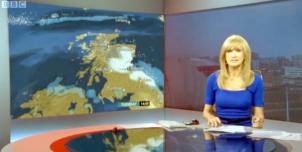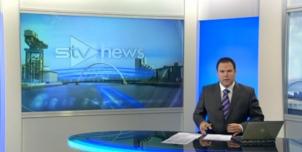Full Freeview on the Black Hill (North Lanarkshire, Scotland) transmitter
| Google Streetview | Google map | Bing map | Google Earth | 55.861,-3.874 or 55°51'40"N 3°52'27"W | ML7 4NZ |
The symbol shows the location of the Black Hill (North Lanarkshire, Scotland) transmitter which serves 940,000 homes. The bright green areas shown where the signal from this transmitter is strong, dark green areas are poorer signals. Those parts shown in yellow may have interference on the same frequency from other masts.
This transmitter has no current reported problems
The BBC and Digital UK report there are no faults or engineering work on the Black Hill (North Lanarkshire, Scotland) transmitter._______
Digital television services are broadcast on a multiplexes (or Mux) where many stations occupy a single broadcast frequency, as shown below.
64QAM 8K 3/4 27.1Mb/s DVB-T MPEG2
DTG-12 QSPK 8K 3/4 8.0Mb/s DVB-T MPEG2
H/V: aerial position (horizontal or vertical)
Which Freeview channels does the Black Hill transmitter broadcast?
If you have any kind of Freeview fault, follow this Freeview reset procedure first.Digital television services are broadcast on a multiplexes (or Mux) where many stations occupy a single broadcast frequency, as shown below.
64QAM 8K 3/4 27.1Mb/s DVB-T MPEG2
DTG-12 QSPK 8K 3/4 8.0Mb/s DVB-T MPEG2
H/V: aerial position (horizontal or vertical)
Which BBC and ITV regional news can I watch from the Black Hill transmitter?

BBC Reporting Scotland 2.4m homes 9.2%
from Glasgow G51 1DA, 26km west (271°)
to BBC Scotland region - 230 masts.

STV News 1.3m homes 4.8%
from Glasgow G51 1PQ, 26km west (271°)
to STV Central (Glasgow) region - 94 masts.
Are there any self-help relays?
| Ardtornish A | Transposer | 22 km NW Oban | 15 homes |
| Balquhidder | Transposer | 12 km NW Callander | 42 homes |
| Benmore B | Active deflector | 50 m WNW Glasgow | 7 homes |
| Blair Drummond | Transposer | 5 homes caravan park | |
| Blyth Bridge | Active deflector | 30 km SW Edinburgh | 50 homes |
| Glendaruel | Active deflector | 40 hotel | 40 homes hotel |
| Glendaruel B | Active deflector | 12 homes (second level) |
How will the Black Hill (North Lanarkshire, Scotland) transmission frequencies change over time?
| 1957-80s | 1984-97 | 1997-98 | 1998-2011 | 2011-13 | 3 Oct 2018 | ||||
| VHF | B E T | B E T | B E T | E T | W T | ||||
| C10 | ITVwaves | ||||||||
| C30 | _local | ||||||||
| C32 | com7 | ||||||||
| C35 | com8 | ||||||||
| C37 | C5waves | C5waves | |||||||
| C40 | BBC1waves | BBC1waves | BBC1waves | BBCB | BBCB | ||||
| C41 | +SDN | SDN | |||||||
| C43 | ITVwaves | ITVwaves | ITVwaves | D3+4 | D3+4 | ||||
| C44 | ArqA | ArqA | |||||||
| C46 | BBC2waves | BBC2waves | BBC2waves | BBCA | BBCA | ||||
| C47 | ArqB | ArqB | |||||||
| C50tv_off | C4waves | C4waves | C4waves | ||||||
| C51tv_off | LG | ||||||||
| C55tv_off | com7tv_off | ||||||||
| C56tv_off | _local | COM8tv_off |
tv_off Being removed from Freeview (for 5G use) after November 2020 / June 2022 - more
Table shows multiplexes names see this article;
green background for transmission frequencies
Notes: + and - denote 166kHz offset; aerial group are shown as A B C/D E K W T
waves denotes analogue; digital switchover was 8 Jun 11 and 22 Jun 11.
How do the old analogue and currrent digital signal levels compare?
| Analogue 1-5 | 500kW | |
| SDN, ARQA, ARQB, BBCA, D3+4, BBCB | (-7dB) 100kW | |
| com7 | (-10.7dB) 42.9kW | |
| com8 | (-11.1dB) 39.2kW | |
| Mux 1*, Mux 2*, Mux A*, Mux B*, Mux C*, Mux D* | (-14dB) 20kW | |
| LG | (-20dB) 5kW |
Local transmitter maps
Black Hill Freeview Black Hill DAB Black Hill TV region BBC Scotland STV Central (Glasgow micro region)Which companies have run the Channel 3 services in the Black Hill transmitter area
|
|
Monday, 24 September 2018
S
StevensOnln15:16 PM
Trevor Jones: Have you retuned since the frequency changes at the Black Hill transmitter on 5th September?
| link to this comment |
Tuesday, 6 November 2018
R
Rupert12:45 PM
Two questions about the September/October 2018 frequency changes at Black Hill.
1. COM7 and COM8 are now on channels 55 and 56, which are slap bang in the middle of the 700 MHz range. How does this help to clear the 700 MHz range for 5g?
2. Craigkelly is also transmitting COM7 and COM8 on channels 55 and 56. Isn't this asking for trouble? I always understood that adjacent transmitters should use different frequencies to avoid interference. Otherwise why not use the same nine channels everywhere?
| link to this comment |
Wednesday, 7 November 2018
MikeP
10:31 AM
10:31 AM
Rupert:
COM7 and COM8 are temporary services and are expected to cease around 2022 when more of the multiplexes are broadcast using the DVB-T2 coding scheme which can carry more data. That cannot be done until most receivers are able to handle that form of coding, but there are still too many older Freeview TVs that cannot, only those marked as Freeview HD can.
All 30 of the main transmitters that are carrying COM7 and COM8 will be using channels 55 and 56 - it's known as a single frequency network and does not cause any known problems. They don't use that scheme for all channels as the programme content differs across the country allowing regional news for example. COM7 and COM8 only carry services that are the same right across the UK.
| link to this comment |
G
GMAN736:27 PM
My area is served by Blackhill, but for some reason today Ive lost all channels that were COM 7 and COM 8 now 55 and 56.
| link to this comment |
M
MikeL8:18 PM
I've lost com7 channels recently still get com8. Signal strength shows 0. I'm in Stirling receiving from Blackhill.
| link to this comment |
M
MikeL8:21 PM
I've lost com7 channels recently still get com8. Signal strength shows 0. I'm in Stirling receiving from Blackhill. Fk7 roof Ariel
| link to this comment |
Thursday, 8 November 2018
R
Rupert5:39 PM
MikeP, thanks for your replies and for clearing up my misconception about interference when adjacent transmitters use the same frequencies. I had thought this was causing poor signal quality on COM7 and COM8 after the recent retunes.
A Freeview engineer said signal quality was fine but fitted a filter in the aerial lead to remove interference from 4g mobile transmitters. Seems fine now.
I'm still puzzled as to how moving COM7 and COM8 INTO the 700 MHz band is supposed to contribute to 700 Mhz CLEARANCE. Seems counterintuitive!
| link to this comment |
Friday, 9 November 2018
MikeP
11:38 AM
11:38 AM
Rupert:
After 2022, or thereabouts, they will not exist at all so will not be in the 700MHz band. 5G is not expected to be generally available until at least 2022 so those multiplexes will not cause any problems as they will be removed in time for the 5G service.
| link to this comment |
R
Rupert8:50 PM
Thanks again, MikeP, but I still don't see how moving COM7 and COM8 from the 500 MHz band into the 700 MHz band is a good idea, even if they will cease to exist in four years time. Why move them at all? What was wrong with leaving them well alone? Still, I suppose it provides employment security for Freeview's engineers!
| link to this comment |
Saturday, 10 November 2018
MikeP
12:19 PM
12:19 PM
Rupert:
The clearance of the 700 MHz band requires a large number of changes to the transmission scheme so that all the required transmissions could be fitted into the frequency spectrum remaining after the move out of the 700 MHz band. That all takes time so Arqiva started several months ago moving some channels to accommodate the reduction in spectrum available after 5G starts. To do that it was necessary to separate out some services into what are called Single Frequency Networks and that is why almost all of the COM7 and COM8 services are on channels 55 and 56 for now. Only 30 of the main transmitters carry those signals.
When it is deemed that most viewers have equipment that is capable of receiving and displaying the DVB-T2 transmission needed for HD services then there will be further work by Arqiva to bring the programme services that are currently on COM7 and COM8 onto the multiplexes that are below 700 MHz. That cannot be done as yet because too many viewers are unable to receive and display HD programmes due to limitations of their equipment (it is necessary to use equipment that is defined as Freeview HD and not 'HD ready' as that only means the screen can show HD but there is no HD decoder built in!). The DVB-T2 encoding is capable of carrying more data, so can be used to broadcast more channels within a multiplex than is possible with the current DVB-T encoding used for the SD multiplexes at present. That will mean fewer multiplexes will be needed and hence COM7 and COM8 will become redundant, so can be switched off to free up the 700 MHz band. So people can expect more changes over the coming three years or so and that's why most are recommending viewers use a wideband aerial that will be able to receive all the current and future transmissions. That aerial could be a conventional type based on the Yagi design of a log-periodic type, both types cover the whole of the allocated UHF frequency spectrum. That means there will not be any need to change the aerial in future.
Hope that clarifies a rather complex subject?
| link to this comment |
Select more comments
Your comment please!





